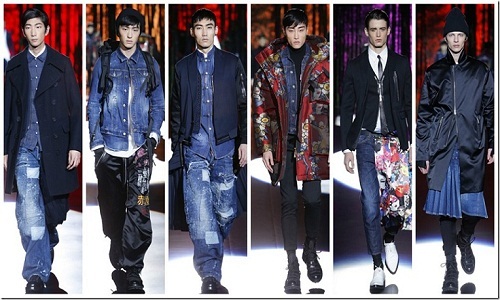FW
Gujarat is set to strengthen its position further as the denim hub of India with around 150 million meters per annum (mmpa) new manufacturing capacity added by 2020.This will be in addition to the existing capacity of 500 mmpa.
Denim production capacity is set to cross 1.5 billion meters per annum in the country. Taking into account projects which are being expanded, and new projects that are coming up, around 300 mmpa of denim capacity is likely to be added during the next four years in the country. Out of this, around 50 per cent will take place in Gujarat alone.
Around four or five new units are coming up in and around Ahmedabad which will add 50 mmpa of capacity . Surat too has six units of denim manufacturing with a capacity of 100 mmpa. These firms plan to add another 30 mmpa in the next few years. The denim industry in India has a healthy growth rate of 1518 per cent per annum. Currently the feasible production capacity is a billion meters per annum considering a 85 to 90 per cent utilisation. Looking at the domestic demand, India will need to double its denim capacity by 2020.
Monsanto in cooperation with the Lubbock Economic Development Alliance (LEDA) announced plans to begin construction of a new, state-of-the-art cotton seed processing facility in Lubbock, Texas. The construction of the new facility is expected to begin in March 2016 and be completed in the second half of calendar year 2017.
With an investment of $140 million, the facility is expected to employ 40 full-time personnel. The site will be established as Monsanto’s primary US hub for all commercial cotton seed processing operations - to include cleaning, treating and bagging of cotton seed - while existing processing facilities will transition to support storage and warehousing, pre-commercial operations and research in various parts of the cotton belt.
Last October, Monsanto announced a number of strategic actions to help drive greater scale in its business and further enhance its overall operations. Location of the new hub facility, Monsanto’s established relationship with LEDA and the opportunity to leverage new production technology factored into the decision to consolidate and optimize its U.S. commercial cotton seed processing operations.
Cambodia may focus on exporting other categories also along with garments. The country feels overreliance on garments may not allow for stable economic development. The other areas for manufacturers to look at are electronics products and machinery. And the reliance on garment exports may fall in the near future. Cambodia’s economic growth has been at seven per cent a year over the last decade, with the expanding garment sector generating about 10 per cent of gross domestic product. Last year, Cambodia’s garment exports to the European Union and the United States were valued at $5.7 billion.
Cambodia can become a manufacturing hub due to its strategic location, but it has many obstacles to overcome, including lack of skilled labor, high energy costs and poor infrastructure. All these are impediments to investment. If these can be overcome Cambodia’s goal of becoming a regional manufacturing hub can be attained.
Cambodia is a member of Asean, one of the world’s largest trade zones, and investors around the world are considering Cambodia as a gateway to the region. Asean’s combined GDP exceeds three trillion dollars and the region is one of the fastest growing in the world. Cambodia is working to attract investment into manufacturing.
Levi Strauss’s fourth quarter and full year 2015 results are unfavorable. The brand’s earnings have been affected by currency headwinds, the associated negative impact on tourism and the challenging global retail dynamics. The company reported 7 per cent and 5 per cent declines in net revenue for the fourth quarter and full year, respectively. On a constant currency basis, the net revenues for the fourth quarter and full year 2015 decreased 1 per cent and increased 1 per cent, respectively. Gross profit for both periods also decreased with the fourth quarter achieving $658 million compared to $680 million in the previous year and the full year achieving $2,269 million compared to $2,348 million in 2014.
On a constant currency basis, net revenues for the year declined one per cent in the fourth quarter but grew one per cent for the full year. On a reported basis, net revenues declined seven per cent in the fourth quarter and five per cent for the full year. Though results were negatively affected by currency translation, net revenue was helped by growth in Europe and Asia.
Direct-to-consumer sales grew mid-single digits on a constant currency basis. This growth reflected expansion of the retail network and increases in e-commerce. Wholesale revenues declined on a constant currency basis for both periods on account of the company’s fourth fiscal quarter having one fewer week compared to the prior year.
The most dramatic growth came in net income, which increased 51 per cent from 2014, reflecting the company’s lower restructuring charges associated with its global productivity initiative, lower interest expense and a pension settlement loss recorded in the fourth quarter of 2014. In 2016 Levi Strauss will continue to invest in its retail network and e-commerce.
www.levistrauss.com/
"What began as regular workwear, denim has gone posh today with Alexa Chung for AG jeans to Marques Almeida and Prada, designers using style and history to create nostalgia and style reinvention. Denim has been growing continuously in the last decade but what’s new is that high fashion has joined the bandwagon of denim affiliation."

After the successful completion of the fourth edition, Denimsandjeans.com brings the 5th edition of their pioneer denim show themed ‘Denim In Fashion’ to Dhaka on March 2 and 3, 2016. This will be Denimsandjeans.com’s fifth consecutive denim exhibition in Bangladesh. The mega denim show is one of the most awaited exhibitions and has been attracting global attention ever since its inception.

What began as regular workwear, denim has gone posh today with Alexa Chung for AG jeans to Marques Almeida and Prada, designers using style and history to create nostalgia and style reinvention. Denim has been growing continuously in the last decade but what’s new is that high fashion has joined the bandwagon of denim affiliation. This explains the theme for the latest edition which is inspired by luxury brands like Prada, Gucci, Burberry and more taking denim seriously and into their collections. Gucci’s has sun-bleached or on neat shirt-waisters with giant pockets. Dolce & Gabbana embellishes their women’s jeans with rhinestones. Burberry, has introduced denim jacket on the catwalk at both their men’s and women’s shows. The collections were full of 70s-style jeans nostalgia with stitching highlighting pockets and boot-cut shapes, teamed with bobbly jumpers and flat sandals. Prada, Louis Vuitton, Stella McCartney, Chloé – mix denim with the other big trends of the season For a few seasons now, many fashion editors have been seen more in Junya Watanbe patchwork jeans than the once universal Cocktail dresses.
Showcasing Bangladesh to the world

Innovation, sustainability and quality, are what Denimsandjeans.com primarily focused on. For the last two years, Denimsandjeans.com has been tapping the potential of Bangladesh and showing to the world the immense opportunities of Bangladesh’s textile industry. In their last edition, ‘Denim Playground Dhaka’, apart from traditional customs of exhibitions, for the first time, students of Bangladesh fashion universities were involved in a contest related to denim products for an international audience. They believe that the best innovation and creations could be delivered only by an enthusiastic learner, and after observing the creations of these students, everyone including exhibitors to international visitors appreciated the work of all these students.
During the last edition ‘Denim Playground Dhaka’ students of three universities BUFT, SMUCT and NIFT participated in a contest organised at the denim show to bring out some innovative designs in denim created by local designer students. In the 5th edition ‘Denim In Fashion,’ as well, young talent will be encouraged to showcase their creations. This time the theme is different, so they expect much more surprising and creative designs from the Bangladeshi fashion students. There is lot more for students, as the selected garments would be showcased by the models in the fashion show ‘Fashionim’.
An event for the international fashion calendar
Last editions of the show were appreciated by visitors worldwide with even the ‘godfather of denim’ Adriano Goldschmied (founder of Diesel) visiting and commenting that the show was much better than expected. All these developments lend credence to the idea of denim quickly capturing space as ‘fashion clothing.’ Perhaps this prompted Denimsandjeans.com to choose ‘Denim In Fashion’ as the theme for the 5th edition.
More than 1,700 visitors from the top global brands/retailers including G-Star, C&A, Celio, Carrefour, Uniqlo, Camieu, GAP, Gloria Jeans, H&M, Levi’s, Li and Fung, M&S, Otto , besides local factories, buying houses etc. extended their support to this exhibition and made it successful. The two-day program comprised of a series of events, sessions and seminars.
The 5th edition has already created the buzz internationally and Bangladesh is ready to host another successful session of this denim show.
Reflected through impressive trade values between the two countries over recent years, the US has become Vietnam's leading trade and investment partner. Bilateral trade has expanded from zero since the day Vietnam and the US normalised their diplomatic ties 20 years ago to $36.3 billion in 2014. The Trans-Pacific Partnership (TPP) agreement is expected to afford favourable conditions for Vietnamese exports among the free trade agreements Vietnam has engaged in, said Deputy Minister of Industry and Trade, Tran Tuan Anh.
According to the Ministry of Industry and Trade (MoIT), Vietnam began to access the US market in 1995. Vietnam's export turnover to the country reached $800 million in 2000 – the year the Vietnam-US Bilateral Trade Agreement was signed. The US has become Vietnam's largest importer, purchasing garments, electronic products, footwear, rice and fish from the Southeast Asian nation. In the sphere of investment, the US ranked seventh among the countries and territories investing in Viet Nam with a total direct investment of $10.7 billion by June this year.
Sending a message to the global market that Sri Lanka is gearing up to become a top fabric destination, the country’s fabric industry is positioning itself to emerge from the shadow of the apparel industry.
The industry’s repositioning comes in the backdrop of knitted fabrics manufacturer Textured Jersey – Sri Lanka’s only multinational mill – becoming the largest textile manufacturer in the region, post-acquisition of Quenby Lanka Prints and Ocean India as its subsidiaries in 2015.
According to Textured Jersey Managing Director/Chief Executive Officer Sriyan de Silva Wijeyeratne, today the fabric industry in Sri Lanka is bigger than some of the historical big local industries and is ahead of other key industries. TJL Group is presently the only one of its kind of this scale and sophistication in South Asia and has set its sights set on becoming a $ 300 million business by 2020.
Pakistan Textile Exporters Association (PTEA) says there has been a drastic downfall of 14.4 per cent in exports of the country since July 2015 whereas exports of the competing country Bangladesh has increased by 8 per cent in the same period. Pakistan’s total exports declined to $12.087 billion in the first seven months of the current fiscal year (Jul-Jan) 2015-16 from $14.115 billion during the same period last year. According to a member of the Karachi Chamber of Commerce and Industry (KCCI), the government without perceiving the significance of time has wasted seven months of the current fiscal year and is still yet to release the trade policy and the new auto policy.
As per the PTEA statement, 5 per cent of the export revenue gets stuck in present refund regime of which resultantly massive working capital has been stuck up which is the major cause of export decline. Refunds of goods exported 12 months earlier are still outstanding, the statement said.
PTEA also complained for being charged above the settled price for Regasified Liquefied Natural Gas (RLNG), while describing the terrible state of Punjab based textile industry because of fuel gas deprivation
Kingpins will debut a new show. ‘Why By Kingpins’ alongside their Amsterdam event on April, 13-14, 2016. Focused on branding in the denim industry, the new event will be also organized by Kingpins Shows’ founder Andrew Olah and Kris Dumon. Located at the Transformatorhuis in Amsterdam’s Westerpark, adjacent to and running concurrently with Kingpins Amsterdam, ‘Why By Kingpins’ aims to act as a platform for denim brands and branding companies.
Attendees will find everything from labels and trim to accessories and innovative technologies represented on the show floor. Like Kingpins, ‘Why By Kingpins’ show will offer complementary seminars and panels, catering and an open bar. Attendees and invitees of Kingpins Amsterdam will also be able to attend ‘Why By Kingpins’ show. Kingpins’s is an exclusive denim show that attracts top brands, manufacturers from across the globe to showcase their latest innovations to specially invited guests. The guests include manufactuers, brands, experts select media among others.
In a recent development, 20 companies from Italy’s Prato fashion district pledged their commitment to Greenpeace’s fashion Detox. The district is home to some of Italy’s oldest textile manufacturers and is Italy's most extensive fashion supply chain, exporting 2.5 billion Euros of clothing annually to retailers such as Burberry, Valentine, Armani and Gucci.
This agreement of companies within the Prato district will affect 13,000 tons of yarn and 13 million meters of fabric each year. These companies have already removed several hazardous chemical groups from its production as required by the Detox campaign. These include brominated and chlorinated flame retardants, organotins compounds, and amines associated with azo dyes that can have negative effects on human reproductive systems and cause cancer.
To eliminate the use of all hazardous chemicals from their global supply chain by 2020, Greenpeace Detox campaign demands that fashion brands avoid the use of all hazardous chemicals. Among the companies joining Detox are Miroglio and Inditex as well as major international brands such as Valentino, Adidas, H&M, and Burberry.












